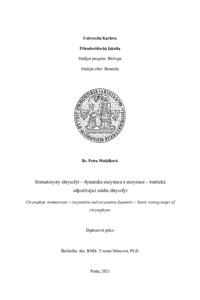Stomatocysty chrysofyt - dynamika encystace a excystace - bentická odpočívající stádia chrysofyt
Chrysophyte stomatocysts - encystation and excystation dynamics - bentic resting stages of chrysophytes
diplomová práce (OBHÁJENO)

Zobrazit/
Trvalý odkaz
http://hdl.handle.net/20.500.11956/150856Identifikátory
SIS: 198408
Kolekce
- Kvalifikační práce [21483]
Autor
Vedoucí práce
Oponent práce
Juráň, Josef
Fakulta / součást
Přírodovědecká fakulta
Obor
Botanika
Katedra / ústav / klinika
Katedra botaniky
Datum obhajoby
2. 9. 2021
Nakladatel
Univerzita Karlova, Přírodovědecká fakultaJazyk
Čeština
Známka
Velmi dobře
Klíčová slova (česky)
stomatocysty, Chrysophyceae, Synurales, dormance, excystace, encystace, nepohlavní encystace, vnější faktory, Ochromonas tuberculata, Synura petersenii, Synura uvellaKlíčová slova (anglicky)
stomatocysts, Chrysophyceae, Synurales, dormancy, excystation, encystation, asexual encystation, external factors, Ochromonas tuberculata, Synura petersenii, Synura uvellaOdpočívající rezistentní stádium hraje v životním cyklu fytoplanktonních mikroorganismů několik významných rolí, především při ochraně před nepříznivými podmínkami a při šíření na nové lokality. Zlativky tvoří početné populace pouze krátkou část roku, a proto je pro ně tvorba odpočívajícího stádia důležitá pro obnovení vegetativní populace následující rok. Chrysofytní odpočívající stádia se nazývají stomatocysty, jsou křemičité a mají unikátní druhově specifickou morfologii. Mohou vznikat jak pohlavním, tak nepohlavním rozmnožováním. Jedná se o málo prozkoumanou oblast. Většina popsaných stomatocyst není přiřazená k popsaným druhům a mnoho se neví o spouštěčích encystace a excystace. Usuzuje se, že zde působí kombinace faktorů vnějších (teplota, světlo, živiny) i vnitřních (stáří buněk a jejich koncentrace). Podrobněji zkoumána byla zatím pouze pohlavní encystace u Dinobryon cyindricum a Synura petersenii. Má diplomová práce je založena na laboratorních experimentech s Ochromonas tuberculata, Synura uvella a s dvěma kmeny Synura petersenii. Zjišťovala jsem, zda mají vnější podmínky, teplota a nedostatek dusíku nebo fosforu, vliv na nepohlavní encystaci a zda je možné pomocí modifikace vnějších podmínek navodit excystaci. Odpověď na stimuly encystace byly kmenově specifické, podpořit encystaci se...
The resting resistant stage has several important roles for phytoplankton microorganisms. It protects them from hostile conditions, allows them to spread to new locations and is often part of their life cycle. Chrysophytes form large populations for only a short part of the year, and therefore the formation of a resting stage is key for them to re-establish a vegetative population the following year. Chrysophyte resting stages are called stomatocysts, which are silicified and have a unique species-specific morphology. They can be form after both sexual and asexual reproduction. This is an understudied area. Most described stomatocysts are not assigned to species and much is not known about the triggers of encystation and excystation. It is thought that a combination of external (temperature, light, nutrients) and internal (cell age and cell concentration) factors are involved. So far, only sexual encystation in Dinobryon cyindricum and Synura petersenii has been studied in detail. My diploma thesis is based on laboratory experiments with Ochromonas tuberculata, Synura uvella and two strains of Synura petersenii. The aim of the study was to investigating whether external conditions such as temperature and lack of nitrogen or phosphorus have the effect on asexual encystation and whether it is...
